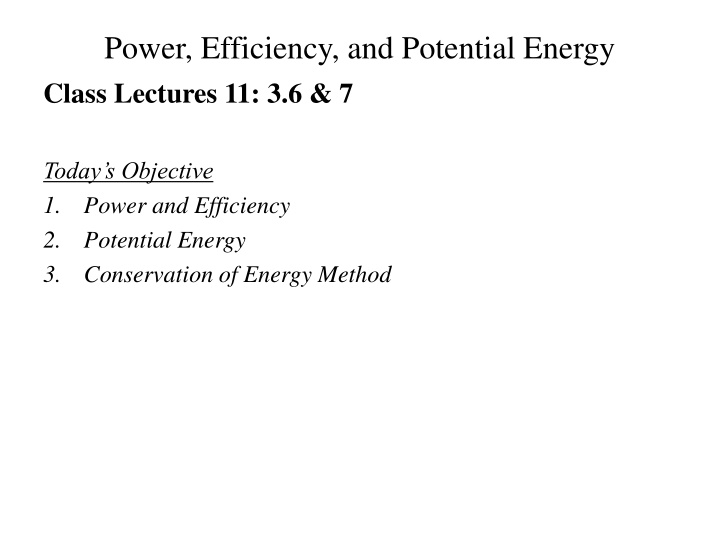
Power, Efficiency, and Potential Energy in Physics
Learn about power, efficiency, and potential energy in physics, including definitions, equations, and practical applications. Explore topics such as work done, energy conversion, and conservation principles. Enhance your knowledge of these fundamental concepts in physics.
Download Presentation

Please find below an Image/Link to download the presentation.
The content on the website is provided AS IS for your information and personal use only. It may not be sold, licensed, or shared on other websites without obtaining consent from the author. If you encounter any issues during the download, it is possible that the publisher has removed the file from their server.
You are allowed to download the files provided on this website for personal or commercial use, subject to the condition that they are used lawfully. All files are the property of their respective owners.
The content on the website is provided AS IS for your information and personal use only. It may not be sold, licensed, or shared on other websites without obtaining consent from the author.
E N D
Presentation Transcript
Power, Efficiency, and Potential Energy Class Lectures 11: 3.6 & 7 Today s Objective 1. Power and Efficiency 2. Potential Energy 3. Conservation of Energy Method
Power Power is defined as the rate at which work is done, Units of power are: Watts and HP
Efficiency Efficiency is defined as the ratio of work output to the work input: If there are energy losses due to electrical and thermal energy, the resultant efficiency is the product of all.
Problem 3/131 Given: WA = 1000 kg, vA = 3 m/s upward Required: Power required for the motor, if the efficiency e = 0.8
Potential Energy Two types of potential Energy: 1. Gravitational potential energy 2. Elastic potential energy Gravitational potential Energy Potential energy is measured from a datum plane Datum can be selected arbitrarily If the Particle s position is above the Datum, it has a positive potential energy and if its position is below the datum it has a negative potential energy
Potential Energy Potential energy can be converted to work Potential energy = work done by the weight As the potential energy is used up, it decreases in value and produces positive work, thus The increase in potential energy will produce a negative work, and vice versa.
Potential Energy Elastic potential energy When a spring is extended or compressed, it stores a positive potential energy The stored potential energy = potential work by the spring force x1 and x2 are the initial and final deflections in the spring.
Work and Energy Equation The equation for work energy with the potential energy included can be written as, Expanding it, we can write, Work energy equation
Conservation of Energy If the forces are conservative, i.e., independent of the path travelled (non-conservative forces: forces produced by friction, heat, sound, etc.), then, conservation of energy equation
Problem 3/139 Given: 2-lb collar released from rest at A. No friction. k = 1.6 lb/ft, upstretched length = 15 in. Required: Velocity at point B
Problem 3/141 Given: released from rest at position A. Neglect friction Required: Velocity at B, Maximum deflection in the spring
Problem 3/152 Given: Released from rest. Neglect friction Required: Speed of mass A and B after B moved 1 m.
Midterm Exam Review Date and Time: Time: Thursday, March 5, 2015 4:30 5:45 Material Covered: Chapters 1, 2, and 3 Number of Problems: 8 10 How graded: 1. No partial credit given for solutions based on wrong concepts. 2. Partial credit given only if there is a math error.
